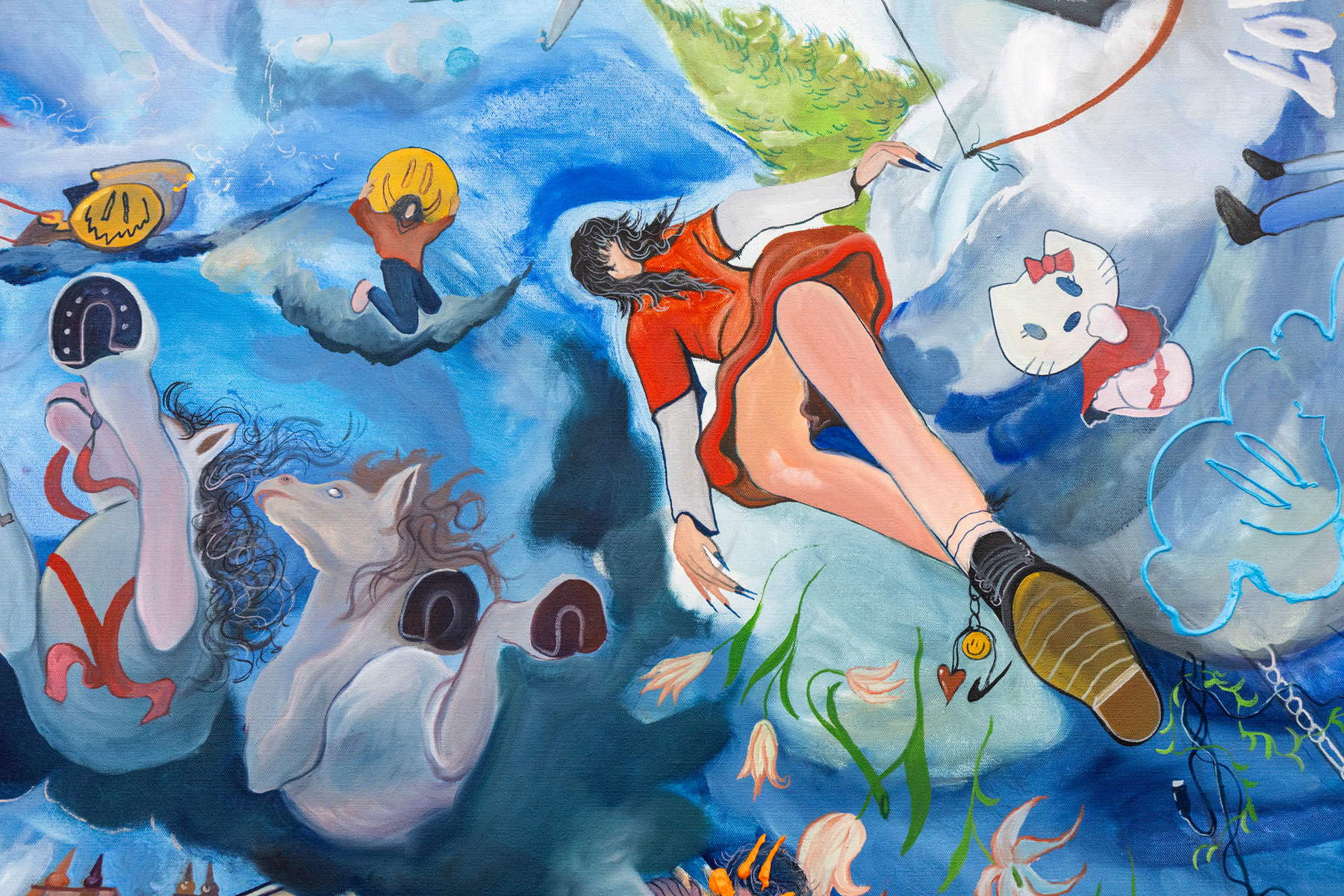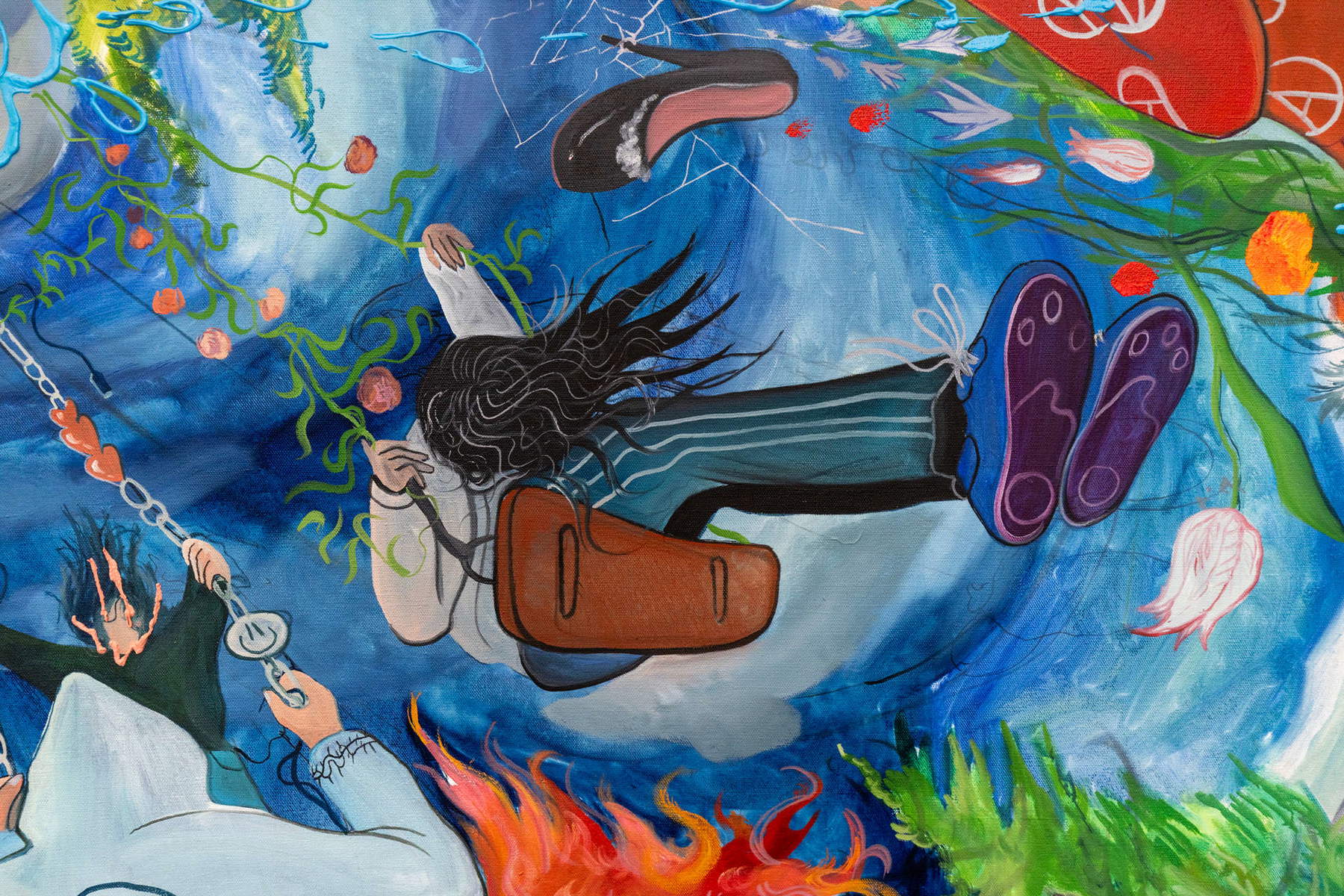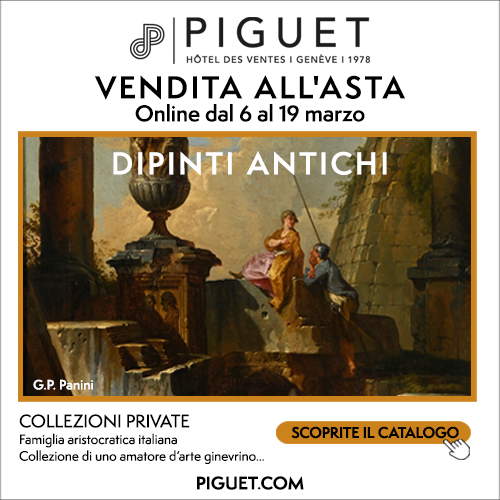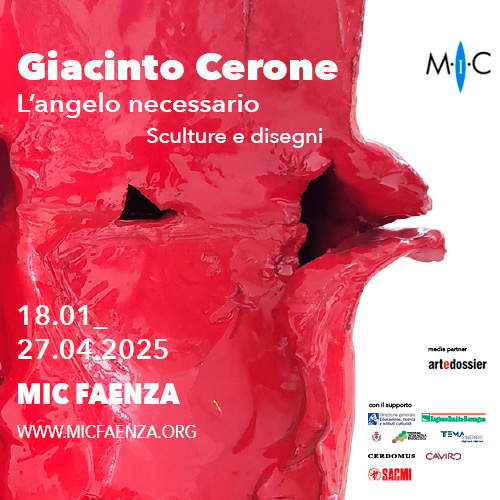Vladimir Kartashov, the Russian artist who brings his cyberbaroque to La Scala in Milan. The interview
From Russia to Italy, where he immediately made his mark despite his very young age: we are talking about Vladimir Kartashov, a Russian artist born in 1997 in Novosibirsk, Siberia. He moved very young to the far east of Siberia, to Magadan, growing up alone, in the middle of nowhere, only with his grandmother and an Internet connection. He then moved to Moscow to train at the academy, and left Russia shortly after the start of the war with Ukraine, finding refuge in Italy, where he currently lives and works (in Pietrasanta). In his artistic practice, Kartashov creates copies of the virtual world and integrates them into daily routines. The main themes of interest are the transformation of our cultural memory on the Internet and the emergence of a new network-related mythology, all in a style that could be called “cyberbaroque”: glitch effects on traditional media, idealized fantasy characters, changes of angle as if due to “delays” in digital communications are just some of the techniques that allow Vladimir to break the traditional perception of perspective and reveal the diversity of a new user-generated reality. After exhibiting his work in a debut solo show held at The Project Space in Pietrasanta, Kartashov received his first major commission: a painting for the ceiling of the Il Foyer restaurant at the Teatro alla Scala in Milan. In this work, perspective converges in the center, creating three-dimensional effects inspired by 17th-century frescoes, but translating them into the context of modernity, establishing parallels between historical trends and the challenges faced by contemporary society in the dynamics of online interactions. These images symbolize different aspects of life and death, emphasizing the Baroque tendency to depict strong contrasts. The thematic scheme tells stories of great tragedies or celebrations typical of that era. A great allegory reflecting the rapidly changing trends in modern society, emphasizing the temporal nature of fashion and innovation. We caught up with Vladimir Kartashov for an interview to hear about his experience in Italy and this painting he is finishing for the restaurant Il Foyer alla Scala.
FG. You arrived in Italy shortly after the start of the war in Ukraine. Meanwhile, how do you find it here with us? What kind of reception have you found?
VK. I arrived in Italy soon after the war started. I was very well received, I like very much that in Europe, and in Italy in particular, nobody gives importance to your origin, what passport you have, but gives importance to what you do and who you are-a good person or a bad person. The reception has been really warm and I consider Italy my second home.
What is your position towards the war?
My position is totally negative. I am a pacifist by character, I find all war and violence disgusting and horrible. But when we talk about Ukraine it becomes very personal moreover. I have many relatives who were connected to Ukraine, my sister lived for many years in Ukraine, it is a very hard and very sad history, I want this war to end as soon as possible. I am against the regime that has been created in Russia, against the situation that has been created, and I hope that Russia loses this war.
Your work is a triumph of colors and motifs inferred from the popular culture of our times. Which artists inspire you the most?
My main artistic purpose is to show the time in which we live, in my works I try to show joy and happiness, modern technologies, my works should reflect modernity with the means of traditional art (oil on canvas in my case). I like Renaissance artists, I have always loved Italian culture, I have studied it all my life, starting from antiquity, then the Middle Ages, 20th century art... If we talk about modern artists, I find real inspiration by looking at Kiefer’s works. He is a large-scale artist who makes an impression. His exhibition at the Doge’s Palace in Venice impressed me. He is fantastic. And then I am also drawn to Daniel Richter and Neo Rauch, with their expression and monumentality.

In His latest work, destined for the ceiling of the Scala restaurant in Milan, we see a pumpkin in the center of a sky from which an explosion originates that invests a whole series of objects and characters. What should we read in this work?
In my painting done for La Scala, I tried to address the Baroque dramaturgy for which it is very important that the plot be either a great tragedy or, on the contrary, a comedy, in the original and ancient sense of the two terms. That is, in the ancient conception, tragedy is something that starts well and ends badly. And so comedy is something that begins badly and ends well, which is why Dante’s Divine Comedy is called that. So I wanted to paint different motifs related to the plays. This car that is turning into the pumpkin is the motif from the fairy tale Cinderella, one of my favorites, where as we remember the carriage at midnight had turned into a pumpkin. And here again we see the car, around the car there is celebration, dancing, music is flowing, people are flying, however, all this happens only for a short time, following which disappointment will come. And so this machine and everything around it is not an explosion, it is a transformation that will happen at midnight. For me, the context of modern times, of the Internet, is important. Modernity imposes on us the rule that says there are no eternal values: every day values, fashion, positions undergo changes. It is a violent river where every day you are a different person. And so the car that turns into a pumpkin is an allegory of modernity, where everything changes and transforms.
Your painting is therefore a kind of great allegory of changes in society. What are the changes that you fear, and how do you experience them? What, on the other hand, are the positive changes?
As mentioned, I aim to convey what I see around me, but I do not take any position. What enters my eye becomes art. All motives are taken from the reality around me. It is difficult for me to say what I fear, to give answers about the future ... for me it is important to keep a distance and to be an observer, an instrument, a brush that can fix our time, but with its own unique perspective. Contemporary is a reality that straddles online and offline. I expect a lot of positive things from this new reality, people have become more open, more global, I like to observe the evolution of everything that happens in the internet - new currents, and I can use all this, sail freely like a dolphin in the waves of the net, take from there everything I like, unite everything on one canvas.



 Vladimir Kartashov,
Vladimir Kartashov,


The characters falling amidst the black hearts allude, from what I understand, to disappointment with virtual environments and the negative influence of the fashions that run on the web. Can you elaborate on what do you think are the risks involved in the web?
In the canvas with the boy with the black hearts there is a romantic motif. Black hearts are symbolic of the fact that love is hard, heavy. There is a new trend related to the Internet and social networks - you can simultaneously have several romantic relationships in social networks, but at the same time actually have no relationship. So the guy on my painting is mired in love intrigue, and all these hearts pull him down.
Your work also appears clearly inspired by the ceilings of large Baroque buildings. What is your relationship with art history and in particular with Italian art history?
I like old masters, classicism, craftsmanship, and I like to combine the culture of European painting with my origins, with my native cultural heritage. I come from Siberia, where the native population is not Russian, the roots of my family are in the native culture, for example even now we practice shamanism. My grandmother was the person who passed on to me the passion for my native culture and passed on all the knowledge she had. I like to be heir to this very strange, magical culture and to be able to create a mixture between these elements. For example, take a baroque composition or a classical composition as a base and add the elements of my “little” culture to it. I love Italian art (especially painting which is more familiar to me than the other artistic spheres) and I find a real joy in being able to experiment with wild mixes where classical painting makes the voluminous elements like masks, smiles, patterns, faces... it’s a global mix - the overlapping of times, of cultures, a huge fusion of my life, my interests, my background. To create this ceiling for La Scala, I was inspired on the one hand by Baroque domes, but also by things that are not related to the Baroque. On the one hand it is a composition with a classical perspective as it must be in the Baroque, but with superimposition of the new patterns, on top of which you put the voluminous patterns and everything comes back in a bubbling mixture.
Do you plan to settle in Italy or do you plan to return to Russia when the war is over?
When the war is over, I will go to Siberia to my hometown to go to the cemetery on the grave of my grandmother, who died when I was by then in Italy and could not come to her funeral. This is very important to me, she was the person the closest to me. But as for my life, I have no intention of returning to Russia to live there. My heart is in Italy with art with the Italian people who welcomed me, with European culture. I belong to the global world, I would like to travel, see the world and live and work in Italy.
Warning: the translation into English of the original Italian article was created using automatic tools. We undertake to review all articles, but we do not guarantee the total absence of inaccuracies in the translation due to the program. You can find the original by clicking on the ITA button. If you find any mistake,please contact us.





























